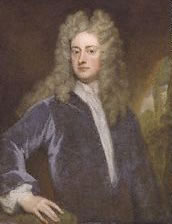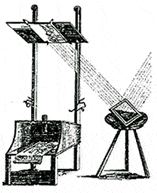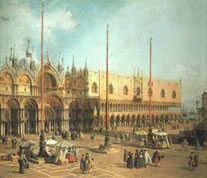 |
| |
|
|
|
| |
|
|
|
| |
1704
JOHN HARRIS (1666 - 1719) |
|
|
| |
Harris was the editor
of the 'Lexicon Technicum' (Dictionary of the Arts
and Sciences, 1704). This was one if not the earliest English
Dictionaries written. A writer of scientific books, Harris presented an
improved camera obscura that contained a scioptric ball in a wood mount
that would enable a panoramic view. |
|
| |
|
|
|
| |
|
|
|
| |
|
|
| |
|
|
|
| |
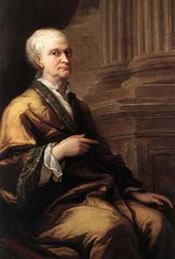 |
1704
SIR ISAAC NEWTON (1642-1727)
The English scientist,
mathematician natural philosopher Newton published his 'Opticks'
in 1704 and went on to explain among other things, the camera
obscura principle using a single convex lens.
In order to illustrate
his seventh axiom, he used the single-lens analogy in comparing
it with vision. This he argued, embodied the answer to Aristotle's
old problem. He also made great use of the simple dark chamber
for his optical experiments with prisms.
Isaac Newton's epitaph
reads "If I have been able to
see further, it was only because I stood on the shoulders of
giants."
|
|
|
| |
Portrait
of Sir Isaac Newton (above) by Sir James Thornhill in 1712. The
original is found at Woolsthorpe Manor, Lincolnshire England, and the
very house Newton was born in. |
|
| |
|
|
|
| |
|
|
| |
|
|
| |
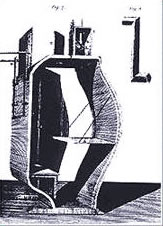 |
1711
WILLEM JAKOB VAN GRAVENSANDE (1688 - 1742)
Gravensande
illustrated a camera obscura in the form of a sedan chair in his
‚€˜Usage de la chambre obscure pour le dessein‚€™ [An
Essay on Perspective, The Hague, 1711]. Gravensande‚€™s design
allowed for a vertically rotatable mirror, seat, drawing table,
and the ability to make panoramas. The device also came with a ventilation
tube. Dr. Charles Hutton will describe in detail this camera in
1814. Gravensande also invented the heliostat, a device utilizing
the sun as a light source in astronomy.
Gravensande's
sedan chair of 1711 (left) was illustrated by Gravensande
in his essay 'An Essay on Perspective'. It consisted
of a seating compartment where the artist would draw from the image
projected down from the roof aperture/mirror. The mirror could be
rotated to allow panoramic views. Apparently there was some sort
of foot peddle which allowed fresh air to be pumped into the compartment
and a periscope-shaped tube for the same. |
|
|
| |
|
|
| |
|
|
| |
|
|
|
| |
|
|
| |
| 1712
JOSEPH ADDISON (1672 - 1719)
This editor of the London
Spectator writes in an editorial this year, ‚€œThe
prettiest landskip I ever saw was one drawn on the walls of
a dark room. Here you might discover the waves and fluctuations
of the water in strong and proper colours, with a picture of
a ship entering at one end and sailing by degrees through the
whole piece‚€Ě. This popularization of the camera obscura
was made after a visit to the Greenwich Park camera by Addison.
The Camera Obscura and Greenwich by Pip Brennan
indicates that over the last two centuries, there have been
a number of camera obscuras at Greenwich. The modern camera
obscura now at Greenwich was built in 1994 in a small summerhouse
adjacent to Flamsteed House, named for the first Astronomer
Royal who set up his Observatory there.
This portrait
(right) of Joseph Addison was painted by Godfrey Kneller
sometime between 1703 and 1712.
|
|
|
|
| |
|
|
|
| |
|
|
|
| |
|
|
| |
|
|
|
| |
|
|
| |
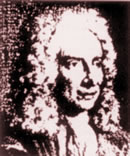 |
1720
WILLEM JAKOB VAN GRAVENSANDE (1688 - 1742)
Gravensande
wrote his ‚€˜Physices Elementa Mathematica‚€™ this
year and described a magic lantern equipped with an oil lamp,
which had four flames. |
|
|
| |
Willem Gravensande |
|
|
| |
|
|
|
| |
|
|
|
| |
|
|
| |
|
|
| |
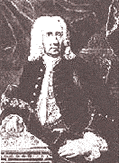 |
1727
JOHANN HEINRICH SCHULZE (1687 - 1744)
It
is generally understood within the photographic historical community
that Schulze gathered the first ‚€œimage‚€Ě on a prepared page.
The image was in fact text, written on a sheet prepared with silver
nitrate and chalk. The sunlight blackened the semi-translucent paper,
leaving white text on black paper. It is not known what Schulze
wrote on the paper.
Johann
Heinrich Schulze (left) was a founding father in the discovery of
photography. Although not able to "fix" his images, he was able
to produce them long before Niepce or Daguerre. |
|
|
| |
|
|
| |
|
|
| |
|
|
|
| |
1727
NICOLAI BION ( - )
Bion
designed a camera obscura for use in copying drawings. It had to
be used in a darkened room, however sunlight was reflected onto
a mirror where the light-image was then seen through the camera,
and the picture was copied.
In
1727 Nicolai Bion fashioned (right) this 'external' camera
obscura into a drawing aid. The mirror on the stool reflected a
specific stream of sunlight within a darkened room, up onto the
picture to be copied (supported above the base). The image of the
picture was then seen through the aperture (in the roof of the base)
and within the base, on the sheet of drawing paper. The foreside
of the camera box is open to allow the artist to work. |
|
|
|
| |
|
|
| |
|
|
| |
|
|
|
| |
|
|
|
| |
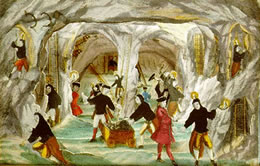 |
1730
MARTIN ENGELBRECHT ( 1684-1756 )
A celebrated engraver of his time, Engelbrecht dominated the
print trade in Augsburg. Best known for his portraits of monarchs
as well as his intricate landscapes, Engelbrecht's work is beyond
compare.
Some of his best work
was with optical prints. He used these in his perspective boxes
and miniature theatres. Typically 8 cards would be inserted
into a peepbox, consecutively, which provided imagery similar
to that of a theatre scene, or play. The view had great perspective.
This
coloured engraving (left) by Martin Engelbrecht showed
people working in a mine. Engelbrecht used rich highlights such
as reds, and gold.
|
|
|
| |
|
|
|
| |
|
|
|
| |
|
|
| |
|
|
|
| |
|
|
|
| |
1732
J. PEELE ( - ) |
|
|
| |
Published a book entitled
'The Art of Drawing and Painting in Water Colours‚€™. He describes
how to build a camera obscura, it‚€™s costs and how it can be used. |
|
| |
|
|
|
| |
|
|
|
| |
EARLY 18TH CENTURY
PIETER VAN MUSSCHENBROEK (1692 - 1761) |
|
|
| |
During the early part
of this century, Musschenbroek very likely was the first to attempt motion
through a simple effect in the magic lantern. Musschenbroek was a Dutch
mathematician and philosopher who took the work of Zahn a step further
by producing two sets of slides. The rear slide was typically the background
and the slide closest to the lens was of the figure or main character(s).
As Zahn had used a circular disk with many pictures, and Kircher had used
a horizontal series of a few slides, Musschenbroek created slides of both
the fore and background, thus producing what was a primitive form of movement.
The forward panel of slides were connected to a string which, when pulled
slightly would give an illusion that the figure was separated, or ‚€œ3 dimensional‚€Ě.
By using two sets of frames simultaneously, Musschenbroek was able to
create a sense of motion for the first time. Musschenbroek‚€™s work would
less than a century later, greatly influence Robertson. |
|
| |
|
|
|
| |
|
|
|
| |
|
|
|
|
|
| |
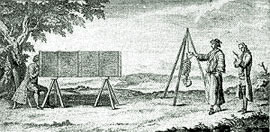 |
1733
DOCTOR WILLIAM CHESELDEN (1688 - 1752)
For
his ‚€˜Osteographia‚€™ (Anatomy of the Bones)
in 1753, Cheselden used a camera obscura to reproduce the human
skeleton on paper. The title page of this book shows an artist pearing
into an oblong camera longer than a man. The skeleton hangs from
a tripod upside down a few feet away, thereby providing the draughtsman
with an upright image. |
For
his 'Osteographia' in 1733, Cheselden used a camera
obscura to illustrate the human skeleton. This diagram (left)
appears in the title page of the book. He gave the camera credit
in the preface, explaining that it improved on previously approved
drawings. The skeleton hangs upside down, providing the artist an
easier job.
In the introduction to ‚€˜Osteographia‚€™, Cheselden notes; ‚€œThen
we proceeded to others, measuring every part as exactly as we could,
but we soon found it impossible this way: upon which I contrived
what I had long before meditated, a convenient camera obscura to
draw in , with which we corrected some of the few designs already
made, throwing away others which we had before approved of, and
finishing the rest with more accuracy and less labour, doing in
this way in a few minutes more than could be done without in many
hours, I might say in days‚€Ě. |
|
|
| |
|
|
| |
|
|
| |
|
|
|
| |
|
|
|
| |
1736
PIETER VAN MUSSCHENBROEK (1692 - 1761) |
|
|
| |
Musschenbroek made a presentation
during this year to the famed scientist Abbé Nollet, in Holland. This
private show consisted of a gentleman taking off his hat, a female walking
down the street and then bowing, and a windmill which appears to revolve.
Through the use of several slides, Musschenbroek manipulated them in such
a way as to imitate motion. Nollet helped Musschenbroek greatly by returning
to Paris to popularize this new sensation in his salon each evening to
the scientists of the day. |
|
| |
|
|
|
| |
|
|
|
| |
1736
ABB√‰ GUYOT ( - ) |
|
|
| |
After seeing the
‚€œmotion‚€Ě lantern of Musschenbroek in Paris during a visit this year, Guyot
will later publish a book called ‚€˜Nouvelles Recr√©ations Physiques
et Math√©matiques‚€™. This book was even later, translated into
English by a doctor in London (1st ed. 1755), W. Hooper (Rational
Recreations In Which The Principles Of Numbers And Natural Philosophy
Are Clearly And Copiously Elucidated, By A Series Of Easy, Entertaining,
Interesting Experiments).
Hooper provided an illustration of the device with an explanation of how
a tempest may be seen . . . . .‚€œOn
one of these glasses you are to paint the appearance of the sea, from
the slightest agitation to the most violent commotion. Observe that these
representations are not to be distinct, but run into each other, that
they may form a natural gradation; remember also, that great part of the
effect depends on the perfection of the painting, and the picturesque
appearance of the design.‚€Ě
Guyot (and Hooper) went on to explain in greater detail how the effect
could be simulated to near perfection (for it‚€™s time). Guyot was known
to use smoke as a backdrop for the illusion of ghosts. The ancient Chinese
and their shadowplays simulated the same results in centuries gone by.
These same shadow-plays grew in popularity throughout Germany in the middle
of this century. Hooper published his 2nd. Edition in 1782 where he described
an original camera obscura having reflecting mirrors mounted on a table
(Ch.2, p36, table 3). |
|
| |
|
|
|
| |
|
|
|
| |
|
|
| |
|
|
| |
1738
ROBERT SMITH ( - )
Smith,
in his ‚€˜Optical Machines for Making Pictures of Objects,
and their Uses in Drawing‚€™, brought attention to a ‚€˜sky-optric
ball‚€™ which he had experienced in a 'shoppe' of one Edward Scarlett
stating it was ‚€œthe broadest lens of this
kind that I ever saw‚€Ě. Scarlett had actually projected
the street scene outside his shop into the store, taking advantage
of his small (and rather darkened, we suppose) window. Smith reported
in his book regarding the use of a mirror to correct the image that,
‚€œthe people
in the street appear upright and without any undulating motion of
the heads‚€Ě.
One
of Mr. Scarlett's business cards (right) from the year 1758.
The upper left corner identifies a scioptric ball lens [second from
the left] manufactured and sold by Scarlett. The card also shows
a magic lantern, camera, spectacles, telescopic lenses, sighting
tubes and mirrors. Scarlett's projection of the street scene into
his shop was an ingenious idea from a business perspective. It would
certainly have attracted prospective patrons and hopefully have
resulted in some sales. |
|
|
|
| |
Robert Smith was an English
mathematician who in this same year (1738) also published 'A
Compleat System of Opticks' and thereby gained the nickname of
'Old Focus'. Smith was made senior fellow of Trinty College, Cambridge
in 1739, and master in 1742. |
|
| |
|
|
| |
|
|
| |
|
|
|
| |
|
|
|
| |
1740
BENJAMIN MARTIN (1704 - 1782) |
|
|
| |
The Englishman Benjamin
Martin was a manufacturer of scientific gadgets and other useable's. He
published several books on said subject throughout his lifetime including
one by the name of ‚€˜A New and Compendious System of Optics‚€™
in 1740. In it he occupied much space telling how the dark room could
be configured for optimum performance. He also spoke about inverting the
image, the scioptric ball and the camera obscura in general. Martin is
quoted as saying ‚€œThis is natures art of painting,
and it is with ease observed, how infinitely superior this is to the finest
performance of the pencil‚€Ě. His
six-volume ‚€˜Biographia Britannica‚€™ of 1755 made strong
references to Della Porta and his ‚€˜Magiae Naturalis‚€™. |
|
| |
|
|
|
| |
|
|
|
| |
|
|
| |
|
|
| |
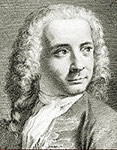 |
1743
GIOVANNI ANTONIO CANAL (CANALETTO) (1697 - 1768)
The
camera obscura is still very much in use as an aid to painting in
the paintings of Venice, by Canaletto. The wide angled views he
painted are presented by historians and commentators like Links
as assurance that Canaletto was greatly influenced by the camera.
Canal painted many 'scenes' of the city for traveling aristocrats.
By the mid-18th century, the camera was well established as an aid
especially in perspective. After painting the Piazza San Marco
(believed to be between 1735 and 1740), he went to England and painted
many landscapes and properties. He returned to Italy in 1755 but
his best work is remembered to be his earlier paintings. Canaletto
called the camera obscura the ‚€˜camera ottica‚€™. |
|
|
| |
| Piazza San Marco
(right) by Giovanni Antonio Canal is perhaps the most often
used work historians will point to when comparing Canaletto with
the camera obscura. It was created sometime between 1735 and 1740
and is a fine example of perspective assisted through the camera.
He often used the camera obscura as an aid to composition and this
can be seen in his many Venetian scenes. For a closer look at the
works of Canaletto and Vermeer, have a look at The
Addio Gallery. |
|
|
|
| |
|
|
| |
|
|
| |
|
|
|
| |
|
|
|
| |
1747
JOHN CUFF (1708 - 1772) |
|
|
| |
An English maker of optical
instruments, such as eyepieces, spectacles and microscopes, John Cuff
was also well known for his interest in the camera obscura. His advertisements
and cards might read ‚€œcamera obscuras for exhibiting
prospects in their natural proportions and colours‚€Ě. An unknown
author (perhaps commissioned by Cuff for marketing purposes) provided
a poem in booklet form which was called ‚€˜Verses occasioned by
the sight of a camera obscura, printed for John Cuff, 1747‚€™.
This poem-story actually tells us of an enacted play of sorts involving
ships a-wreck but the ‚€œpicture fades‚€Ě
upon the opening of a door and the light entering in. One can easily envision
those re-enactments of the showmen Villeneuve (SEE
1290 Villeneuve) and Cardano (SEE 1550
Cardano). A portion of the poem helps us to remember the importance
of the lens to invert the image; ‚€œHow the Clown
stares! Smit with surprise and love, To see th‚€™inverted pretty Milk-Maid
move, With pail beneath her head, and feet above‚€Ě. The author
describes the colours of the crystal fountain and garden provided on a
‚€œclear white sheet‚€Ě. |
|
| |
|
|
|
| |
|
|
|
| |
|
|
|
| |
|
|
|
| |
|
|
|
| |
|
|
|

|
| |




